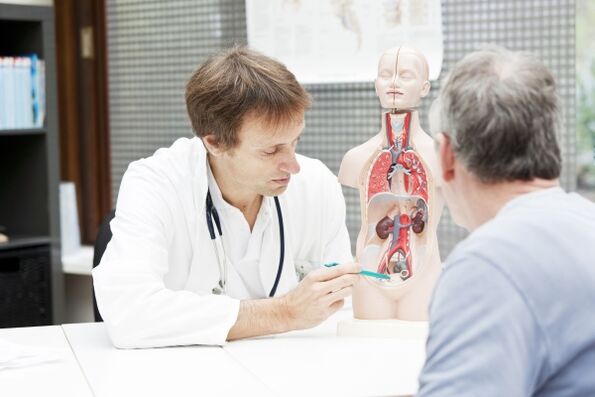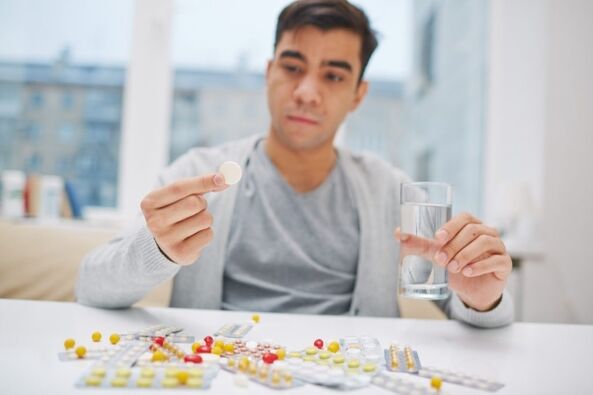If you do not want to prevent chronic prostatitis, carefully study the causes of the disease, pay attention to the signs of chronic disease, and be sure to read the rules of diagnosis and treatment.Read our article to know all this.
Chronic prostatitis is characterized by a long-term inflammatory process within the prostate, leading to disorders of prostate morphology and function.Its pathology is difficult to eliminate and its complications are serious, so it is easier to prevent it if you understand why it occurs.
reason
The main cause of the chronic course is untreated prostatitis, which progresses to the next stage.The following reasons and factors may cause this:
- Infection of the urogenital tract with Mycoplasma, Chlamydia, Herpes, Ureaplasma, Candida, E. coli, Cytomegalovirus or Trichomonas.
- Congestion of the pelvic organs occurs against the background of a sedentary lifestyle, impaired blood supply, poor nutrition and bad habits.
- Frequent hypothermia (risk groups include people who surf, dive, ski, etc.).
- Long-term abstinence, behavioral disruption.
- Obesity due to fatty foods.
- Endocrine system disorders.
- Systemic inflammatory processes, especially chronic inflammatory processes.
- Weak immune system.
- Injury to reproductive organs.
- Persistent constipation.
- Depression, stress, overwork.
Special attention should be paid to bad habits - drinking, drug use, smoking.The harmful substances released by such products can cause vasospasm and reduce blood circulation levels.As a result, nutrition in all organs deteriorates.
symptom
With chronic prostatitis, the prostate enlarges, compressing various parts of the genitourinary system and narrowing the urethra.As the disease progresses, the glands completely surround the urethra, severely compressing it.This is why urine output problems occur.
How to recognize chronic prostatitis:
- Periodic pain in the pelvis and perineum;
- Discomfort during urination and defecation;
- Discharge from the urethra was observed;
- Pain spreads to thighs, testicles, and anus;
- Have urinary problems;
- Severe burning and itching of the urethra;
- frequent urges;
- Decreased libido and erection;
- Rapid ejaculation with pain;
- If an infection occurs, the body temperature rises and the condition worsens;
- One year later, infertility occurred;
- Pain after normal physical activity;
- acute urinary retention and false urges;
- Slow flow of urine.
In the initial stages, symptoms appear slowly, but as the disease progresses, symptoms intensify.The pain syndrome becomes very intense, radiating to nearby organs and areas.Special attention should be paid to the process and frequency of urination.Against the background of this change, men experience psycho-emotional problems, manifested in the following aspects:
- severe anxiety;
- depression or, conversely, aggression;
- Insomnia at night;
- obsessed;
- Fear of sexual intercourse and urination;
- Bad temper and irritable.

Classification
The current classification requirements for chronic prostatitis were formulated in 1995.Accordingly, diseases are divided into:
- Chronic bacterial prostatitis.Occurs in the context of untreated acute bacterial illness.It shows typical symptoms but is accompanied by increased body temperature, chills and fever.On examination, an increased number of white blood cells and pathogenic microorganisms were detected in secretions and urine.
- Chronic prostatitis occurs most frequently.
- Asymptomatic inflammatory prostatitis is characterized by the absence of specific signs.Most often discovered by accident.
Statistically, the most common form is nonbacterial prostatitis.The bacterial form is less common (up to 10 cases in 100).This is because symptoms are always obvious after infection, so patients usually receive prompt examination and treatment.
Possible complications and consequences
Chronic prostatitis alternates between exacerbations and remissions, and the inflammatory process rapidly destroys the prostate, with the result that the following complications arise, considered the most dangerous for human life:
- adenoma.It is formed in the prostate.Prolonged inflammatory processes lead to intense cell division.At the same time, the glandular epithelium in the ducts proliferates, increasing the size of the organ.Against this background, benign hyperplasia occurs.
- Cancerous growths in the prostate.More commonly seen after prostate adenoma.Identifying cancer in the early stages of tumorigenesis is problematic.This is because men with chronic prostatitis can experience the same symptoms.Therefore, patients must undergo appropriate urological testing to detect prostate-specific antigen in the blood.
- Significant reduction in erections and further impotence.This is the most common unpleasant consequence.The disease develops in a certain order.At first, the erection weakens slightly, then the erections become less regular and ejaculation occurs very quickly.Additionally, libido decreases and the patient experiences pain during ejaculation.Then there's impotence.
- Infertility.It occurs within a year after the chronic course of prostatitis.In fact, chronic inflammatory processes lead to reduced sperm counts, slowed sperm motility, and destruction of the tail and head.Infertility can be determined through a sperm chart.
- Seminal vesiculitis.The inflammation occurs in the seminal vesicles, which contain sperm.
- swollen bladder sphincter, acute urinary retention occurs in this context, leading to death.
- Sclerosis of the prostate.The disease occurs when the prostate is replaced by connective tissue.That is, connective tissue cords are formed, which can lead to sexual dysfunction.
Other consequences:
- Cyst formation;
- Prostate stones;
- hemorrhoid;
- Cystitis;
- Psychological instability requiring treatment.

If a man is diagnosed with chronic bacterial prostatitis, he will only be able to use condoms for sexual intercourse because the disease can cause his partner to become infected.The bacteria invade the fallopian tubes, reproductive tract and organs, causing disease and female infertility.
Which doctor is treating you?
Urologists treat the male genitourinary system.But if this is your first time visiting a clinic for a similar problem, you'll first need to see a therapist.
When taking diagnostic measures, it is also necessary to consult other highly specialized doctors - infectious disease specialists, psychologists, depending on the cause of the disease.
diagnosis
During the initial visit to the andrologist, the doctor first collects a medical history, which includes the following:
- Research medical history of urological, infectious, chronic and other diseases;
- Interview patients about lifestyle and unhealthy habits;
- Determine factors contributing to pathology;
- Ask the patient about the nature, type, and duration of symptoms.
Doctors have since performed a visual and tactile examination of the man and referred him for further examination.
laboratory methods
What is being done:
- Collect secretions from the urethral tube.Identify the causative microbiota, mucus, and white blood cells.
- PCR – scraped from urethra.Pathological factors identified.
- Microscopic examination of prostate secretions.Macrophages, amyloid, Trousseau-Lallement bodies, and leukocytes were counted.
- Immunological tests to assess levels of nonspecific antibodies.
- Blood is collected to determine PSA levels.If high levels are detected, an additional prostate biopsy will be performed, which will rule out or confirm cancerous tumors.
Instrumental methods
Instrument diagnosis is as follows:
- Prostate ultrasound.A transrectal approach (sensor inserted into the rectum) is usually used.By studying the size and echostructure of the prostate and the density and uniformity of the seminal vesicles, the stage of the disease and its shape can be defined.
- Pelvic floor muscle myography and urodynamic studies.Identify neurogenic disease and bladder outlet obstruction.
- Magnetic resonance and computed tomography.Detection of pathological diseases of the pelvic organs as well as cancerous tumors.Thereafter, a differential diagnosis is established.
Differential diagnosis
Establishing a differential diagnosis is necessary because it allows timely identification of the following diseases:
- prostate cancer;
- Bladder dysfunction of neurogenic etiology;
- Diseases of the detrusor sphincter system;
- False synergy difficulties;
- Bladder stricture;
- Bladder neck hypertrophy;
- Cystitis;
- adenoma;
- Prostatic sclerosis, etc.

Treatment of chronic prostatitis
Treatment of chronic prostatitis is comprehensive - medications, massage, physiotherapy and exercise.Of particular importance is the correction of the patient's own life - complete abandonment of bad habits, proper nutrition, normal sexual intercourse.In some cases, the help of psychotherapists and psychologists is needed.One treatment method cannot be used alone as each method is complementary to the other.
Indications for hospitalization
Treatment of chronic prostatitis is carried out on an outpatient basis, but some patients require hospitalization - when severe complications are detected, in advanced forms of the disease and when there are no positive results during treatment.
antibiotic
Antimicrobial drugs are used to treat chronic bacterial prostatitis.The choice of drug depends on the type of pathogen.The duration of treatment is 2 to 8 weeks.The purpose of antibiotics is to destroy pathogenic microorganisms and reduce the inflammatory process.
Use different groups:
- Aminopenicillin group.
- Cephalosporins.
- Macrolides.
- Fluoroquinolones.
alpha blockers
This group blocks adrenergic receptors in the tissues of the pelvic organs, thereby preventing bladder spasms, improving urine outflow, and facilitating the urination process.In addition, the function of the muscular system and sphincter muscles returns to normal.
NSAIDs
Chronic prostatitis is characterized by an inflammatory process of the prostate, necessitating the administration of anti-inflammatory non-steroidal drugs.Their purpose is to relieve pain and eliminate inflammation.In addition, nonsteroidal normalizes the permeability of the walls of the circulatory system, restores blood circulation, and in this context existing inflammatory mediators are not absorbed.
Products are available in the form of gels, tablets, and injections.
hormone therapy
Hormone drugs are prescribed if nonsteroidal (non-hormonal) drugs have no positive effect or if the patient has a hormonal imbalance.They eliminate inflammation and help stimulate erectile function and tissue regeneration.
Restore blood circulation
Since prostatitis worsens microcirculatory processes in the genitourinary system, doctors prescribe appropriate medications.When blood circulation returns to normal, the regeneration process begins and local metabolism accelerates.As a result, patients quickly get rid of unpleasant symptoms.In addition, many products can strengthen blood vessel walls and reduce blood viscosity.

Other medicines
In addition, for chronic prostatitis, drugs from other groups are used:
- The purpose of muscle relaxants is to relax muscles, relieve pain, increase blood circulation and reduce the tone of the smooth muscles of the reproductive organs.
- Immunomodulators correct immune changes but are mainly used when patients suffer from immunodeficiency.
- If stones are found in the prostate, the patient should take medications that regulate uric acid.
- In order to destroy established adhesions and accelerate the course of action of nonsteroidal anti-inflammatory drugs and antibiotics, enzyme drugs can be used.
- Vitamin and mineral therapy strengthens the immune system.Medications are chosen based on specific vitamin or mineral deficiencies.
- To restore the metabolism of the prostate and regenerate damaged tissue, bioregulatory peptides are used, which are produced from prostate glands harvested from cows.
- If the disease is accompanied by anxiety, depression, aggression and other mental disorders, sedative drugs or selective antidepressants are prescribed: valerian, motherwort tinctures.
surgery
Surgical intervention is rarely used in chronic prostatitis and only when surgery is reasonable and there is no risk of complications.Additionally, there is a considerable recovery period after surgery.
When is surgery needed:
- In the absence of positive results after complex conservative treatment;
- Prostate abscess;
- tissue suppuration;
- Unable to urinate:
- benign prostatic hyperplasia;
- cancerous tumors;
- Other complications.
prostatectomy
The surgery involves removing the prostate and, in some cases, lymph nodes.Radical prostatectomy can be divided into the following types according to the surgical method:
- Robotic type - several small incisions are made in the lower abdomen and the prostate is removed (the movements are controlled by a special robotic device);
- Open – An incision is made in the lower abdomen;
- Laparoscopy - A small incision is made and a microscope camera and instruments are inserted.
Features:
- Any type of surgery is performed under general or local (spinal) anesthesia.
- The duration of this procedure is 2 to 3 hours.
- The recovery period is one and a half months.
- The maximum length of stay for patients is three days.
- The time to start sexual life is one and a half to two months.
- In many cases, the catheter is left in place for a week.
- Complications are rare but treatable.
transurethral resection of the prostate
The surgery involves cutting the tissue around the prostate to make it easier to urinate.To do this, a resectoscope inserted into the urethra is used.The procedure is indicated in the absence of urination, as well as in the prevention of such complications - hematuria, inflammatory processes in the kidneys and bladder, stones, urinary incontinence.
Features:
- Intervention duration – one hour to one and a half hours;
- Stay in clinic – 2 days;
- Wearing a urinary catheter - 5-7 days;
- Recovery period - one and a half months;
- Initiate sexual activity after 6 weeks.
abscess drainage
This surgery is used to treat prostate abscess, a complication.With this disease, large amounts of purulent exudate accumulate in the prostate and must be drained.During the procedure, a needle is inserted into the gland under the control of an ultrasound device.The method is similar to puncture.
Before the injection procedure, the urologist feels the prostate by inserting his index finger into the rectal opening.After the pus is aspirated, it is disinfected and drained with a rubber tube.If the patient has an extensive abscess, the pus is aspirated via the perineal route (i.e., rectum).
Features:
- The surgery lasts an hour and a half;
- The maximum time spent in the drainage cavity is 72 hours;
- Recovery period - one month.
laser surgery
Laser treatment is an innovative and most common technique as the procedure is considered less invasive, safe and has a short recovery time.During the procedure, a laser instrument is installed inside the urethra and its beam removes excess tissue.In this case, no incision is made.
There are two types of resection: ablation (excess tissue is burned) and enucleation (tissue is cut away).Depending on the type of removal, laser surgery is divided into the following types:
- Photoselective vaporization – laser vaporizes tissue.
- Holmium laser ablation - The procedure is the same as the previous one, but using a holmium laser.
- Holmium laser enucleation - Prostate tissue is crushed with a morcellator and then removed.
Features:
- Minimal number of contraindications;
- No adverse reactions (bleeding, etc.);
- You can go home immediately after surgery;
- Wear the urinary catheter for 24 hours;
- Recovery period – up to 7 days;
- The only drawback is that it cannot be used to treat cancer.
What may happen after any type of surgery:
- bleeding;
- Temporary difficulty urinating;
- Infect;
- urinary incontinence;
- Retroejaculation (when sperm enters the bladder);
- swelling of tissue;
- Weakened erection;
- Inguinal hernia;
- Shortening of the length of the penis (only if part of the urethra is removed).
To prevent complications, you must strictly follow all of your surgeon's recommendations during recovery.You cannot treat yourself.

physiotherapy
Through physical therapy procedures, it is possible to reduce inflammation levels, relieve pain, eliminate tissue swelling, and improve the effectiveness of medications.What to use:
- Phonophoresis;
- electrophoresis;
- laser treatment;
- Transrectal microwave hyperthermia.
massage
Massage is one of the mandatory procedures in the treatment of chronic prostatitis.It is recommended to be performed by a specialist, but if this is not possible, it can be done at home (but another person should perform the massage movements, since the patient is in a relaxed state).
Contraindications to massage:
- Proliferative changes in the prostate;
- Presence of stones in organs;
- venous stagnation;
- Formation of cysts and other tumors.
Program progress:
- The man should expose the lower part of his body and lie on his side with his knees pulled up to his abdomen.
- There is another position - knees and elbows.
- The person performing the massage must wash their hands thoroughly, wear medical gloves, and lubricate their index fingers with Vaseline or other emollient.
- The masseuse inserts a finger into the anus (man relaxes).
- Massage the prostate with gentle strokes.
- The duration of this process is 2-5 minutes.
If a man lives alone and cannot see a massage therapist, a special urinary massager can be used.Your treating urologist will help you choose the best model for you.
diet therapy
Patients with prostatitis must adhere to a special diet to prevent the formation of cholesterol plaques, constipation and increased gas formation.Dishes must be steamed or boiled.Can be baked but not with oil.
Authorized products:
- seafood;
- pumpkin seeds;
- non-gas-producing fruits and vegetables;
- porridge;
- fermented dairy products;
- dried fruit;
- Lean meat and fish.
Prohibited products:
- any legume;
- cabbage;
- carbonated drinks;
- Alcohol;
- spicy and salty dishes;
- strong tea and coffee;
- Yeast baked goods.

folk remedies
Traditional drug formulas can only be used with the consent of an andrologist, as many of them may have contraindications.
recipe:
- Eat about 30-40 pumpkin seeds a day, preferably on an empty stomach.
- You can drink pear preserves, but only without sugar.
- Take medicated baths 3 times a week.To do this, make a decoction of herbs in proportions of chamomile, sage, pine needles, calendula.Brew according to the standard protocol (one cup of water - 2 tablespoons of mixture).Pour into the bath solution, add sea salt in a free proportion, and take a sitz bath for 15 minutes.The water temperature should not be higher than 40 degrees.
- Use parsley - add to salads, juice and drink.Seed parts can also be used.
- Make your own rectal suppositories.To do this, mix propolis with butter and cocoa powder in equal proportions.Shape into a candle shape with your hands, wrap each suppository in plastic wrap, and place in the refrigerator.Take 1 suppository each night before bed for 30 days.
forecast
If we talk about prognosis, it directly depends on many circumstances - the degree of neglect, the form of the disease, the adequacy of treatment, the behavior of the patient himself.If the development of chronic disease is detected and treated promptly and correctly, the prognosis is quite good.
However, you need to know that complete cure of this disease is very rare, but it is possible to achieve a stable remission, during which no symptoms will occur.
Patients must strictly adhere to preventive measures throughout their lives, undergo regular check-ups and take medications.
Precautions
To prevent the development of chronic prostatitis and its exacerbation during remission, follow simple rules:
- Contact a urologist promptly;
- Maintain a healthy and active lifestyle (eliminate bad habits and engage in moderate exercise);
- Eat right;
- Sex life should be regular - at least 3 times a week;
- Monitor the status of the immune system;
- Don’t be too cold;
- Exclusion of casual sex;
- Training of the muscles of the genitourinary system - special exercises.
If you have chronic prostatitis, don’t panic because it’s not a death sentence.With the right treatment and regular visits to your andrologist, you can live an active sex life without unpleasant symptoms.













